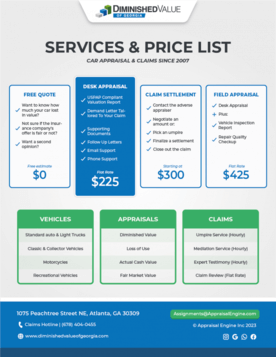Betterment in Auto Insurance Claims, what is it and how can you calculate it?
Betterment is defined as the increase in value a vehicle experiences after a major mechanical repair. It is applied to items that wear out and are usually replaced during the automobile’s normal life. For example:
- Timing Belts
- Exhaust
- Catalytic Converter
- Engine
- Transmission
- CV Axle
- Water Pump
- Tires
- Brake Pads and Rotors
- Air filters and Cabin Filters etc..
In other words, items that a vehicle owner needs to repair or replace during the normal lifespan of his car.
Car buyers will pay slightly more for a vehicle that has a fresh new timing belt as this is a very expensive repair. Betterment is the opposite concept of Diminished Value.
Example:
You own a $25,000 sedan. You run over some broken glass on the highway and all your tires go flat. On your way to the curb you run over a cinder block and damage the undercarriage of your vehicle. There is no police report (clean carfax) and no physical or cosmetic damage. Your insurer puts brand new tires on your vehicle and replaces the engine with a new one.
Pre-Accident Condition: Tires at 40% and a 70,000 mile engine
Post-Repair Condition: Brand New tires and a new engine
The insurance company pays $6,500 for the repairs, betterment in this case would be a percentage of the vehicle’s initial value. Prospective buyers will pay more for a vehicle with a new engine and new tires. Betterment in this case could be $2,000 or more.
On the other hand, a $6,500 collision repair to the front-end of your vehicle (bumper, hood, fenders etc..) would diminish the value by $2,000 or so. The concepts are exact opposites.
Loss in Value Questionnaire (Will take 2 minutes of your time)
Please fill out the form below to receive a FREE Diminished Value estimate.







